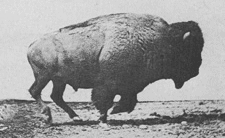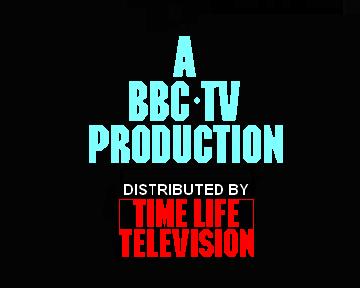THE WORKS OF TINTO BRASS
Chagall
(a.k.a. Marc Chagall, 1952–1962)
Henri Langlois, the semi-insane chief of the
Cinémathèque Française, started work on this documentary
about his friend Marc Chagall (1887–1985), in 1952 or thereabouts.
The IMDb has the story, though a bit garbled:
|
[Henri Langlois] had a wish to make a 35mm color-film with painter Marc Chagall.
Chagall came with the idea to portray his life by means of his paintings.
Langlois started filming in 1952
and in 1954 he asked Joris Ivens to supervise and edit the already large amount of shot material.
In 1958, when Ivens (with assistant Tinto Brass) edited most of it,
and Langlois finished the last recordings, the film suddenly disappeared.
It was never found again.
|
The above is correct in regard to Joris Ivens and Tinto Brass.
As soon as Tinto began with the Cinémathèque, he was apprenticed to Ivens,
and it was Ivens who taught him the arcane mysteries of editing, which became Tinto’s first love.
It’s a terrible shame that the movie seems no longer to exist.
I can’t believe it just disappeared.
Somebody disappeared it, for reasons we cannot know.
|
In 1954 Ivens had received a letter from Henri Langlois, the driving force behind
the French film archives in Paris, the Cinémathèque Française. Obsessed
by cinema and capable of irrepressible passion, Langlois was
convinced that a film needed to be made about the painter Marc Chagall,
and in the early fifties he had visited and filmed his idol with the French
documentary filmmaker Frédéric Rossif. Langlois and Rossif had fallen out
and ended their collaboration. Langlois then traveled to the Soviet Union in
order to make a pilgrimage of famous sites from Chagall’s youth with the
widow of the director Alexander Dovzhenko. In 1954 he felt able to write to
Ivens that the film was in an advanced state of completion. All they needed
was a director to bring the work to a satisfactory conclusion, and Langlois
and Chagall agreed that, apart from the late Dovzhenko, only Ivens ‘had
enough commitment... to link the unreal images with the reality of our day...
without losing the poetry.’ They asked Ivens to supervise the
film.44
|
Footnote 44. Virginia Haggard, 7 Jahre der Fülle. Leben mit Chagall, Zürich 1987, 194–195.
Henri Langlois writing to JI, 26 August 1954. JIA, pl. no. 50.
JI writing to Marion Michelle, undated (March 1957), 1 January and 18 August 1958.
MM.
Marc Chagall writing to JI, 1 August 1957. BA/FA, Coll JI SW 4.
|
Three years passed before Ivens had time for the project, and it was not
until the summer of 1960, after the editing of
NANGUILA
TOMORROW, that
the work could be rounded off. In Beaujolais, at the country home of
Langlois’s friends Jean and Krishna Riboud, they filmed Chagall’s paintings
on the billiards table. ‘Everything is fine here’, Ivens wrote to Ewa
Fiszer, ‘except that Henri wants to work day and night... he wants to cut and
recut, and after six hours of insane work with 16mm film, oh my eyes, we go
back to the starting point of my original cut’. Back in Paris Ivens was wary
about returning to the Ribouds’, because Henri ‘wants to work when I’m
there, changing ‘Chagall’. The film is good. He should realize that an artist
has to be able to let go of a work. He can’t do it, he’s an amateur and a historian.’
It was August 31, 1960[,] and Ivens was satisfied with what he saw as the
final version. Ewa Fiszer saw the film and described it: ‘It was mainly
paintings, that was what Chagall wanted, a succession of fantastic
images.”45 The
work was never shown in Europe. Rumor has it that Langlois made the material
available to the American producer Simon Schiffrin, who won the Oscar
for the best short documentary in 1964 with a film entitled
CHAGALL.
|
Footnote 45. JI writing to Ewa Fiszer, undated (August 1960), 31 August 1960 and undated (late August–early September 1960). EF.
Ewa Fiszer interviewed by the author, 24 May 1991.
|
|
The above two indented quotes tell us pretty much all we know about this movie.
A web page about David Perlov
indicates that Chagall was never completed,
but, then, that page is not too accurate, as it wrongly posits that Langlois was merely the producer, while Ivens was the director.
Another
web page about Perlov is looser with the phraseology, leaving needed wiggle room.
A brochure about Ivens repeats the incorrect claim that it was he who directed the film.
The brochure goes on to mention that “only a few unclear rushes” of Chagall were discovered after a long search.
I would like to see those rushes.
The rumor about Langlois supplying Schiffrin with the materials
could well explain why various sources confusedly treat the two Chagall films as one.
As you plug this info into Google and similar engines, you will find correct claims that among the camera
operators were Frédéric Rossif and Jean Guynot, and that the assistant
editor was David Perlov, but
some of these references continue with the claim that the producer was
Simon Schiffrin, that the
director was Lauro Venturi, that the music was by Joseph Kosma, and that the narration was by Vincent Price.
Those latter credits refer to the the Oscar-winning short film made in 1963 (released in New York City on
17 September 1964) also called
Chagall.
Actually, the situation is even a bit more confusing.
Vincent Price’s narration was for the English-language version.
We can see from this clip
that the original French version had narration by Claude Dauphin.
The French, English, and Spanish versions were issued on
DVD in France in 2010. That’s all a bit of a tangled tale, isn’t it?
Schoots’s story combines several names of monumental importance:
Jean and Krishna Riboud, Henri Langlois, Joris Ivens, and Tinto Brass.
There is one more name that goes unmentioned in Schoots’s text:
Roberto Rossellini, who was also at the Cinémathèque at the time,
putting the finishing touches on India matri bhumi and
J’ai fait un beau voyage. Neither could be finished on location
since Rossellini had been kicked out of India
for having scandalized his government sponsors by carrying on an affair with his married scenarist,
Sonali Sen Roy Dasgupta, who was also now living in Paris and pregnant with their son Gil.
This is almost certainly how and when Roberto Rossellini met Riboud’s ombudsman, Claude Baks
(yes, a real name in Latvia), who arranged to help finance La lotta dell’uomo per la sua sopravvivenza and
who appeared on camera portraying René Descartes in Blaise Pascal.
Baks also apparently had a business arrangement with Rossellini for a project called Caligula,
though no paperwork relating to this contract is known to survive.
A thought: If the rumor about Langlois giving Schiffrin materials is true,
then it would follow that, at one time or another, Schiffrin had at least portions of Langlois’s version of Chagall.
It would follow also that Venturi, as director, would have had access to at least some of the material in Schiffrin’s hands.
Schiffrin died in 1985.
Lauro Venturi died in 2010.
Might their executors know where the source materials are stored?
Shall I tangle this tale even more?
Courtesy of a friend in Antwerp, on Wednesday, 4 May 2016, I received the DVD of the Schiffrin/Venturi Chagall,
which includes a brochure consisting of excerpts from Venturi’s unpublished autobiography, Lauro’s Movie Time.
Venturi quotes a letter from Schiffrin to publisher Albert Skira:
|
Dear Monsieur Skira,
I presume that your collaborator, Lauro Venturi, has kept you informed
about our project to make a film on Marc Chagall. I know
from Chagall himself that you have made an agreement with him,
signed on a 100 Franc bill, and that he considers himself bound to
you. Apparently this film would please him very much, as he would
like, considering his age, to “leave a living memory” of himself.
On the other hand he is a very difficult man to please, and you
are one, if not the only one, who could if necessary have influence
or authority on him. You know that a film on Chagall could arouse
interest in the States as well as Europe: a well-made movie can be a
commercial success, and will certainly obtain a prize.
|
So there you have it!
Mystery solved!
Chagall, difficult to please, felt bound to Skira and Venturi.
He had probably tired of Langlois, and I presume he demanded all the footage,
which would explain why it vanished from the Cinémathèque.
Chagall may have allowed a few snippets of Langlois’s film to be incorporated into Venturi’s.
So if anybody has the Langlois version, it would be the Chagall estate.
Who wants to search for it?
It is imperative that we locate and rescue this lost film.
I’m not going to try.
I don’t speak French, Russian, Yiddish, Dutch, or Hebrew.
I am not in any way connected with the art world or the film world.
I am certain that nobody would listen to me or even acknowledge receipt of my query,
not even if paid to do so.
(With the rarest exceptions,
people in the arts and in showbiz for some reason refuse to deal with the rest of us.
Ask the simplest question, for instance about the availability or condition of preprint materials,
and you get shot down with a barrage of inquiries about your credentials:
“Who sent you? What have you done? Where have you performed? What have you published? Where?
What kind of car do you drive? Who do you work for?”
and the aggressive interrogation goes on and on and on and on and on and on and on and on.
No matter how you answer, you fail the test, with a grade of 0%.
I have no idea why this is.
People in the arts and in showbiz talk only with others in the arts and showbiz,
and only on recommendation of people with whom they already do business. Bizarre.
Historians don’t behave that way.
Physicists don’t behave that way.
Archæologists don’t behave that way.
Showbiz and the arts, though, yup.)
This is a job for somebody else to do, somebody who does have connections.
If you find the film, though, please let me know.
This is vitally important to me, and not only to me.
Chagall
| Written and directed by |
Henri Langlois |
| Camera |
Frédéric Rossif, Jean Guynot |
| Edited by |
Joris Ivens |
| Assistant editors |
Tinto Brass, David Perlov |
|

